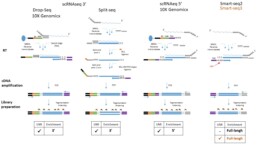scRNAseq
Transcriptome analysis at the single cell level allows to reveal the cellular heterogeneity of complex and tumoral tissues, to identify rare cellular subpopulations and to follow the dynamics of cellular evolution during development or as a response to its environment (cellular interactions, pathogens, treatments, etc).
The method is based on the capture of the few molecules (~105) of polyadenylated RNA in the cell, the addition of deoxycystidines in the 3′ of the 1st cDNA strand using the specificity of the murine leukaemia virus (MMLV) reverse transcriptase. These added nucleotides are complementary to a template switching (TS) oligo, which allows the reverse transcriptase to “switch” to replicate the 2nd strand of cDNA towards the 5′-end.
Several protocols are available depending on the method of cell isolation and the project approach (Figure).
- Cell encapsulation in droplets (10X Genomix Chromium)
- Dropseq uses the capture of mRNA on beads by a polydT oligo carrying barecodes and UMIs. This high-throughput method is designed for 3′-end sequencing and transcript counting .
- The symmetric of the Drop seq consists in using, attached to the beads, a TSO oligo combined with barecodes and UMIs. In this configuration, it is the 5′-end fragments that will be sequenced.
- Combinatorial indexing on cell pools.
- Split-Seq (Rosenberg et al. 2018)is a method that does not require any cell isolation instruments. Through ligations of barecode/UMI to CDNAs in successive rounds of split-and-pool, each transcript will carry a particular, cell-specific combinatorial indexing. This method is effective for studying gene expression profiles and identifying cell populations.
- Cell sorting (FACS, Fluidigm C1, CellenOne)
- Smartseq 2 (Picelli et al. 2014) : This method differs from the previous ones by introducing an LNA ( locked nucleic acid) at the 3′-end of the TSO in order to improve the cDNA synthesis yield.This method, which can also be used on total RNA, allows full-length transcripts to be analysed and isoforms to be detected.
- Smartseq 3 :In this version of the protocole, the TSO sequence is different and incorporates UMIs to overcome PCR bias and optimise transcript counting.


